The MSI Z170A Gaming M7 Review: The Step Up to Skylake
by Ian Cutress on September 21, 2015 12:30 PM EST- Posted in
- Motherboards
- Gaming
- MSI
- Skylake
- Z170
MSI Z170A Gaming M7 BIOS
When MSI launched their second graphical BIOS/UEFI interface, it was quickly praised as implementing more ‘user experience’ than some of the other options on the market. At the time it used more color, different icon placement, and something a bit more than just tabs at the top of the screen. Fast forward a few years and MSI still had the same base layout for Z97 motherboards. There were minor updates – an XMP button, a proper overclocking menu layout, some help menus and fan controls, but it still had the same look and feel when other manufacturers were implementing ‘Easy Mode’ and a few other features to separate the common tools in the BIOS from some of the more esoteric. Now, MSI joins that crowd.
We still have the ClickBIOS nomenclature, but this at first glance looks like a nice ‘Easy Mode’. A BIOS gets plus points for system information on screen one – the motherboard, the processor, the speeds, voltages, BIOS version, temperatures and fan speeds. Rather than apply a thick layer, MSI separates easy mode into a few options on the left, so we have CPU info above, as well as memory info giving a per-module rundown:
Storage:
As well as fan controls:
In the top left of the screen is MSI’s Game Boost button, so users can apply the auto-overclocks without opening the case and moving the wheel on the motherboard. Next to this is an XMP button for a one-shot XMP enable. In the fan screen above the fan gradients are not adjustable directly but there is a settings cog next to the fan numbers to take the user to the fan adjustment menu:
This fan adjustment menu is similar to previous MSI BIOSes, which when released was a nice touch giving users a graphical control over their fans.
Elsewhere in the easy mode is a help guide to show what settings the Game Boost does:
We also get a favorites menu, an option to flash the BIOS and the hardware monitor, which is another link to the fan control. MSI also links to the ‘BIOS Log Review’, which brings up a list of BIOS changes since entry, similar to what we have seen on other motherboards.
Pressing F7 moves into the advanced mode, which gets a lick of color by virtue of the Gaming brand design.
As far as the advanced mode goes, it runs in line with previous MSI BIOSes we have seen before. Each of the buttons around the sides gives access to different sub menus:
Nothing much out of the ordinary here. Although it is worth pointing out how to install Windows 7 on this motherboard – the option is in “Settings/Advanced/Windows OS Configuration”:
Put ‘Windows 7 Installation’ to enabled, and this will allow the user to use a USB mouse/keyboard during install. It is worth noting that Win7 has to be installed via a CD/DVD in this context as data-based USB drives are disabled. Normally we install an OS via a USB, and while the installation program for Win7 does start up, it refuses to find any OS version to install in an odd twist whereby the BIOS can read the USB stick but the USB stick can’t read itself.
The overclock menu retains the new option we saw on Z97 by offering a ‘Normal’ and ‘Expert’ mode for those that understand the processor to a deeper layer by giving more options. Typically we recommend most users stay with the CPU multiplier and CPU voltage settings, which gives great overclocks for most – however extreme (sub-zero) overclockers always want more control.
I’m going to point out a continual issue I have with MSI motherboards, and it relates to the VDroop control / load-line calibration.
The concept of this feature is to maintain a constant voltage across the processor (because drawing current causes a drop), and it helps with stability. Current processor design has an amount of voltage drop when the processor is being used heavily, in order to keep power consumption reasonable for the cooling used. However, for overclocking stability it can be adjusted with great benefit.
Other motherboard manufacturers understand this, and make the concept of this easy to understand. ASRock shows a graph of voltage drop with CPU load and five gradients, allowing a user to choose a gradient. ASUS has a series of options from Auto to Low to Extreme, with a recommended setting listed on the side. GIGABYTE also does something similar. With MSI, it makes no sense to anyone apart from the MSI engineer.
Here the VDroop Offset control comes in Low to High, but the values next to these names differ from +0% to +12.5% up to +100%. For anyone not an MSI engineer, +100% would automatically sound like ‘doubling’ the CPU voltage. This would mean 1.2 volts to 2.4 volts, which is crazy. This is clearly not what MSI is doing, but whatever that option does, +100% is the wrong way to describe it to an end user, especially one experimenting with overclocking for the first time.
I’ve emailed MSI many times about this, over many years, and even discussed it face to face, but it is very clear I am not being understood correctly. Sometimes I get an email back explaining what VDroop is. I know what VDroop is, but I don’t know what this control does because it is badly explained and the numbers mean nothing without context. ‘It should relate to load line level’ is the closest I have to a meaningful quote on this matter from MSI, but still no-one has explained the difference in pure scientific terms what going from +12.5% to +25% does, or what +25% even adjusts and to what degree. It clearly doesn’t add +25% to voltage, which is the only option VDroop is directly related to, so it might refer to some form of internal resistance. Well without a baseline, there’s no indication if +25% or +75% will go from a bad overclock to a good overclock or a quick VRM shutdown followed by the smell of smoke.
So I imagine that this option is fully understood by MSI engineers, and MSI’s internal overclockers who work on the motherboard and BIOS teams. But not everyone is an engineer, and there is a disconnect between the engineers and the teams that deal with users and the media in explaining certain features. Sometimes I receive critical feedback about MSI not overclocking as much as other motherboards – if this option was easier to understand, it might make a difference.
Ranting aside, the rest of the BIOS falls in line with flashing tools, fan controls, and Board Explorer:


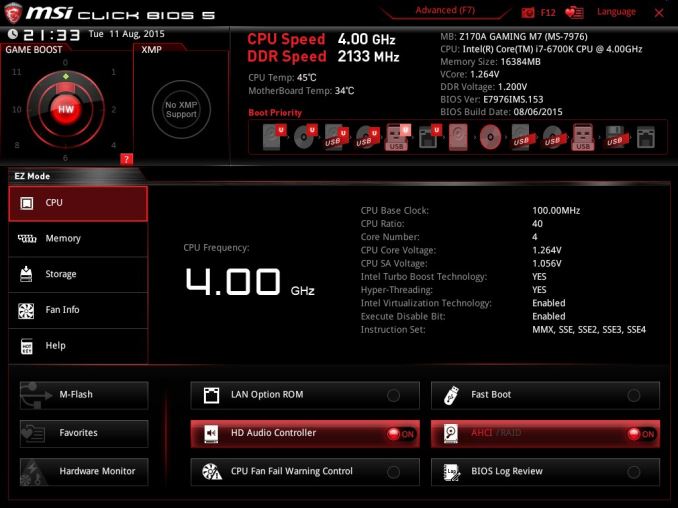
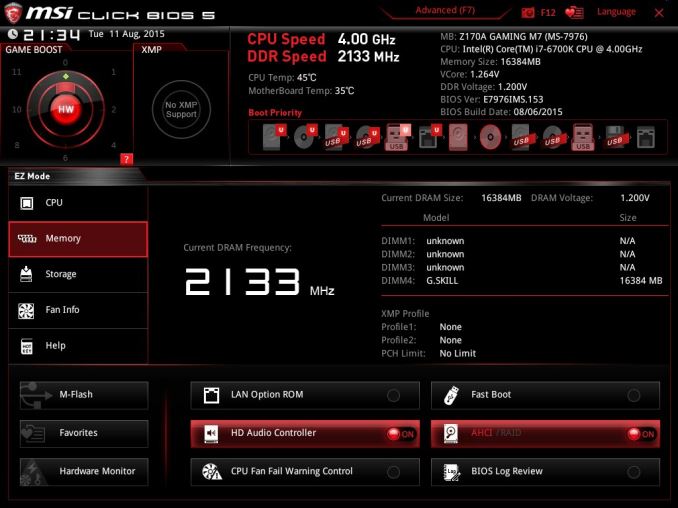
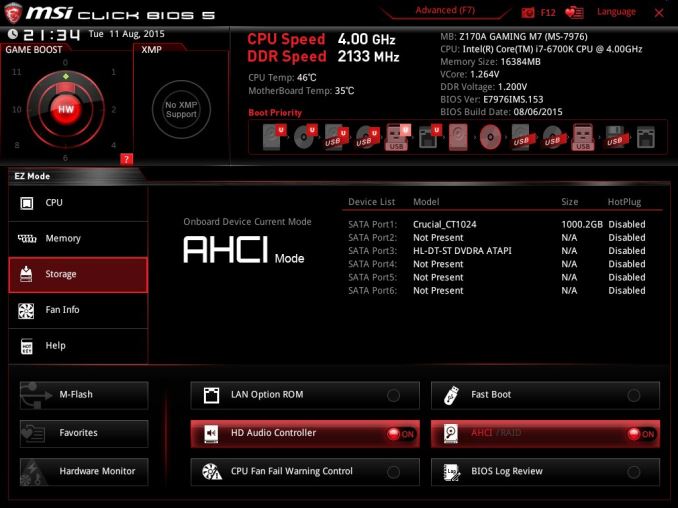

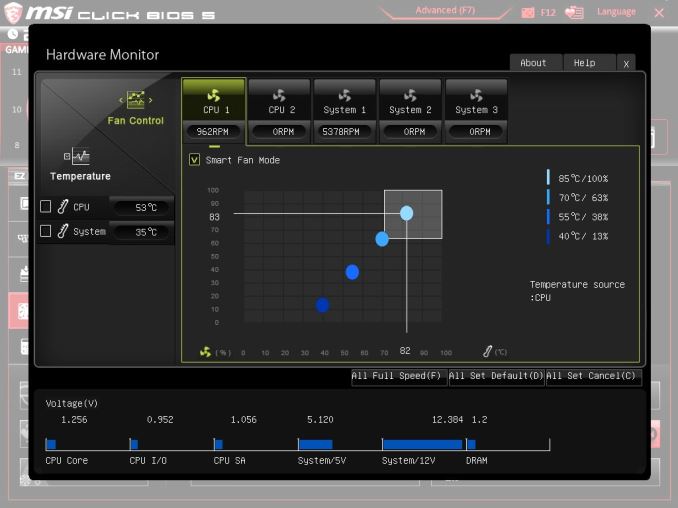
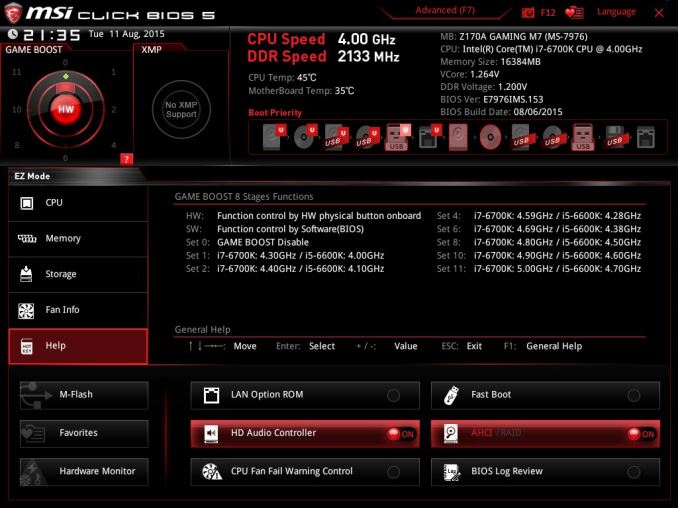
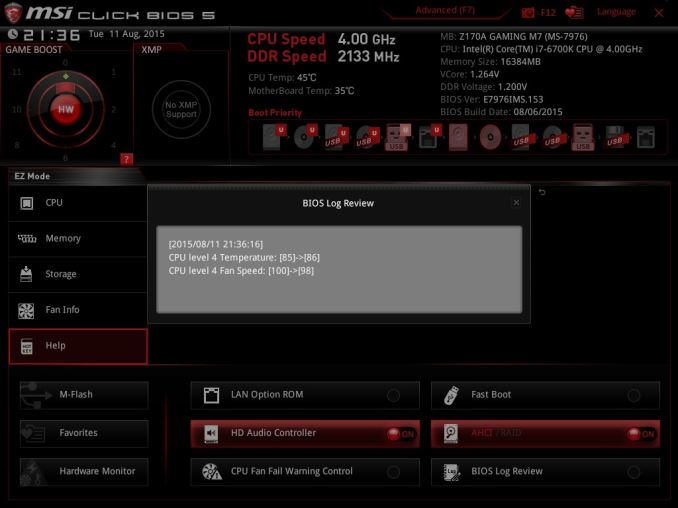
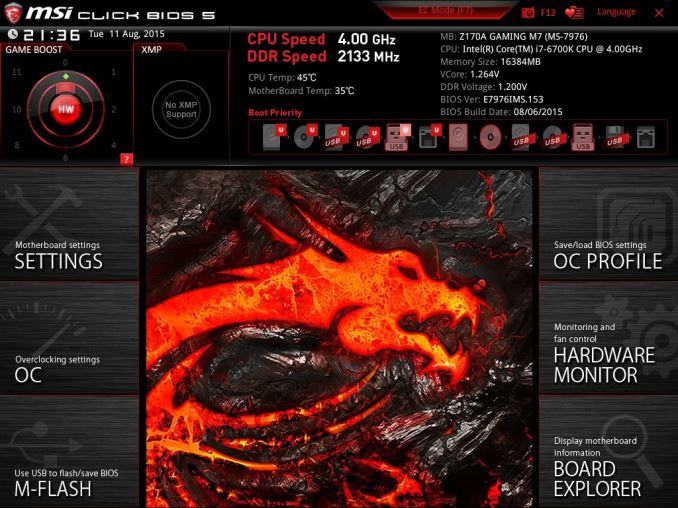
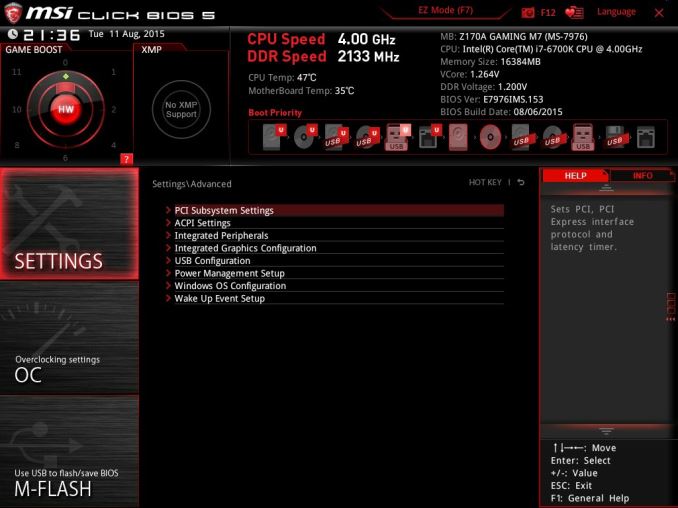
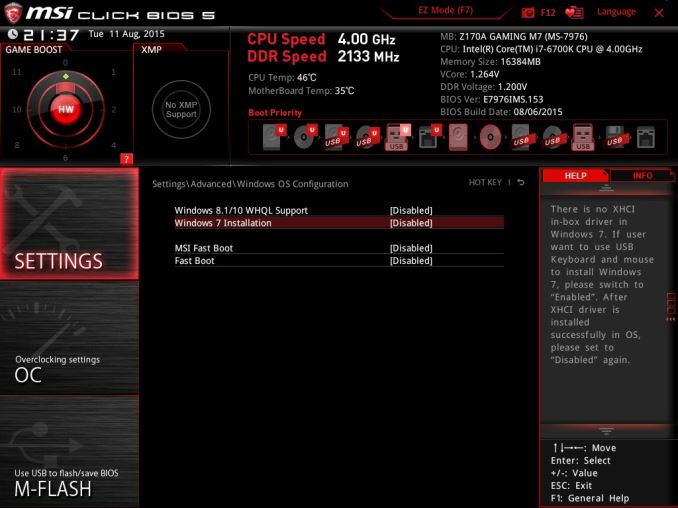
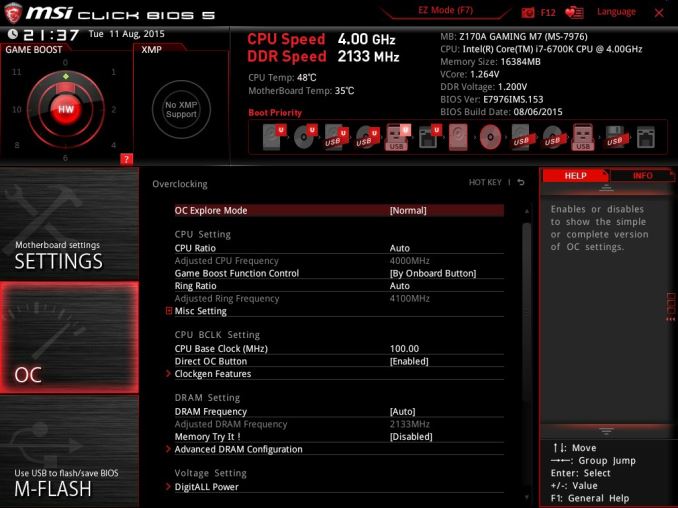
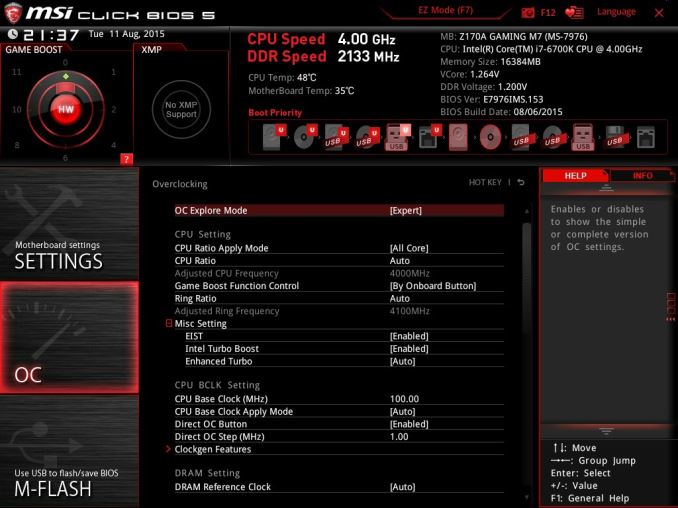

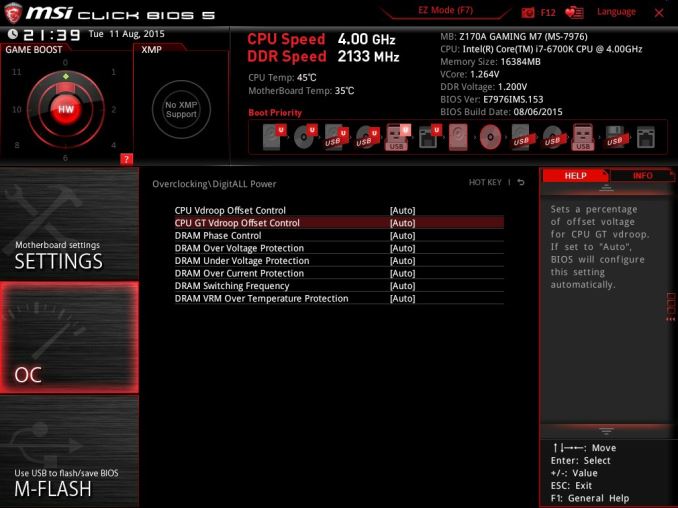
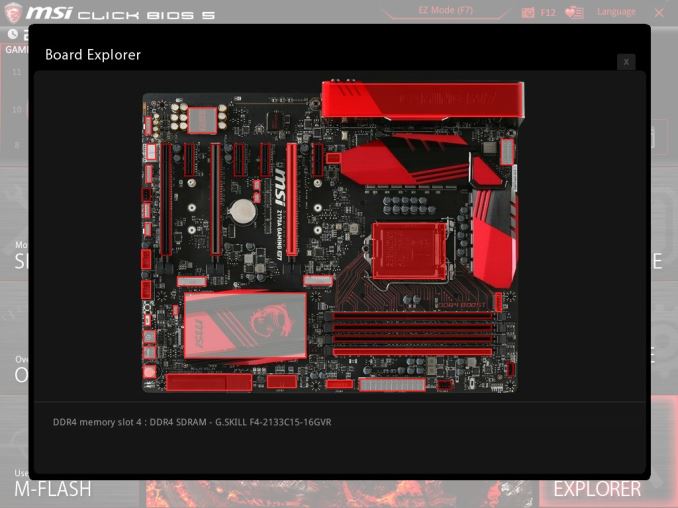














56 Comments
View All Comments
Byrn - Monday, September 21, 2015 - link
Thanks for the review! Any chance of an article looking at using two PCI-E 3.0 x4 M.2 SSDs in raid using Intel RST? SM951s for preference ;)drtechno - Thursday, October 1, 2015 - link
Byrn -- In short, you CAN'T. The MSI boards (all of them) do not support BOTH M.2 slots running in PCI-E x4 mode. If you plug in two M.2 drives, the second slot drops to SATA mode. It says it right there on MSI's web site.I don't know why this review (and many other reviews like it) don't point out that most of the boards with dual M.2 slots do NOT support dual PCI-E x4 mode. The second slot drops to SATA in almost all the boards.
The only board I have come across that supports dual PCI-E x4 modes on M.2 is the Gigabyte boards.
Byrn - Friday, October 2, 2015 - link
drtechno - Huh, thanks for the heads up. Totally missed that on the detailed spec. Only MSI board this doesn't seem to be the case for is the Z170A xpower gaming titanium edition, which doesn't have this excluded on the spec.That said, all the more reason for an article or even a brief piece on the subject? I can't be the only one looking at multiple M.2 slots for PCI-E SSDs (RAID or not) and it would be good to at least have this pointed out...
Looks like I'm buying Gigabyte then (not that MSI was looking good with Nahimic and Killer even before this...)
LoganPowell - Friday, November 27, 2015 - link
Too bad that the MSI z170a gaming M7 is not very popular if you look at consumer based reviews (such as http://www.consumerrunner.com/top-10-best-desktops... which is my favorite).xthetenth - Monday, September 21, 2015 - link
What is it with MSI trying to sell products by paying to attach negatives to their products? First Killer, which is working its way up to debatable and now Nahimic, which is outright bad.Flunk - Monday, September 21, 2015 - link
I'd argue that Killer has worked it's way down from debatable to useless and are trending downward. Before they were bought out Killer's nics were at least interesting with their hardware implementation of features that other brands do in software. Now they're 100% marketing.Nahimic is at least optional.
Impulses - Monday, September 21, 2015 - link
Little to no value + extra potential hassles galore, definitely a downside in my book.DanNeely - Monday, September 21, 2015 - link
The problem is that it takes a few years for stuff like killer going down the toilet to work it's way from we enthusiasts to the sheeple who pick their board based on the logos and pictures on the box.notR1CH - Tuesday, September 22, 2015 - link
They're actually worse than the Realtek or Intel NICs because you're forced to use Killer's awful drivers. Very disappointed to see MSI yet again buying into this gaming marketing dribble from Killer and making another don't-buy board.PPalmgren - Monday, September 21, 2015 - link
Speaking of bad onboard sound, I may be having buyer's remorse at the moment. I went with the Asus Maximus VIII Gene on my build and have been having trouble diagnosing system hangs for about a week since I built it. I think it may be ASUS' onboard sound solution. I tried closing out their Sonic Suite and ROG EQ stuff and it breaks sound in many applications, so I'm starting to worry that I'm SOL